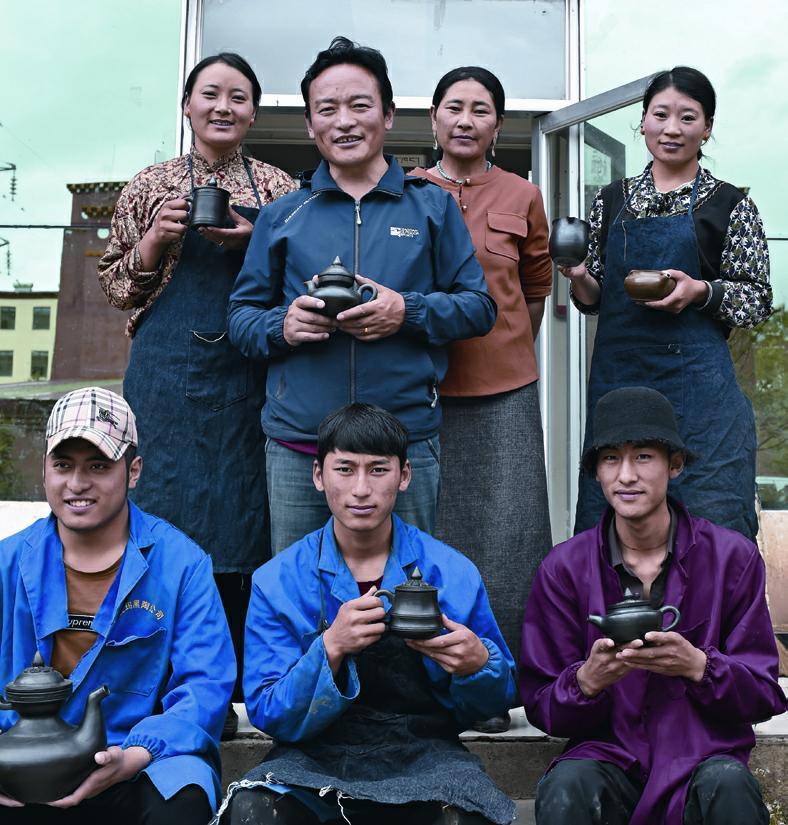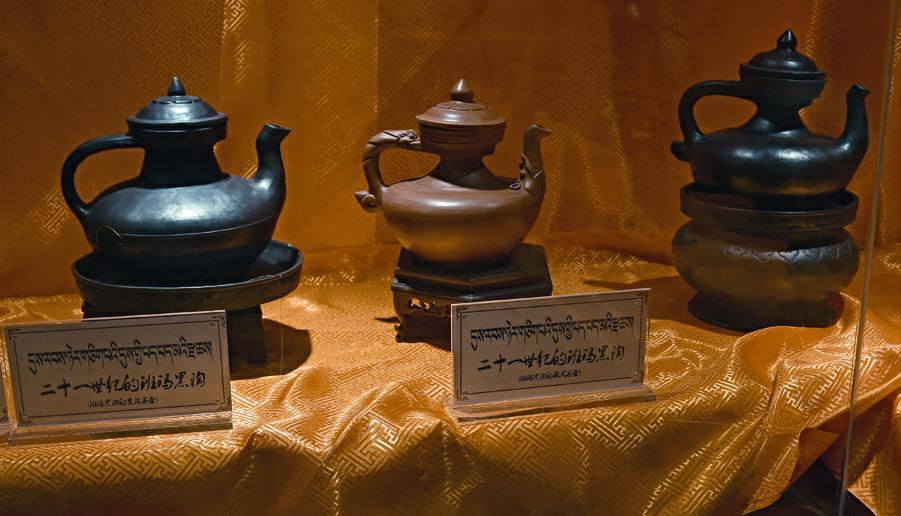The Return of Baima Black Pottery
2019-12-24BystaffreporterGUOQING
By staff reporter GUO QING

THE potters face is clouded in concentration as his hands move effortlessly over the black clay bowl spinning on an electric wheel. He shapes and trims the clay with ease only gained from much experience, in a workshop in the Baima Cultural Industrial Park in Golog Tibetan Autonomous Prefecture, Qinghai Province.
Black pottery vessels, having a history of thousands of years, are generally made for daily use on the Qinghai-Tibet Plateau. Historically, the pottery artifacts were only produced in Ngari of Tibet Autonomous Region, Yushu and Golog of Qinghai Province, and Dechen of Yunnan Province. In Baima County, which is located in Golog, black pottery making techniques have been developed and passed down for nearly 600 years, and have been listed as a national intangible cultural heritage.
There are many kinds of black pottery products in Baima, such as pots, lamps, urns, and jars. Apart from being employed in everyday use by the Tibetan people, the pottery is also an essential part of religious and cultural activities. Today, the black pottery is not only a vehicle that conveys Tibetan culture, but also a product that can improve the livelihoods of local artisans.
Inheritors of Baima Black Pottery
She Getai, 40 years old, was born into a family of skilled black pottery craftsmen in Baima. At the age of 12, he began to learn pottery, clay sculpture, and mask-making from his father. The process of making a black pottery pot has to go through a long series of procedures, which include finding the suitable earth, drying it, making mud, baking, blackening, and polishing. From a mound of earth to a piece of art, the production involves 13 procedures, which not only requires consummate skills and physical strength, but also great patience.
“When I was a child working as an apprentice under my father, he would get angry at me if I became absent-minded. But he never punished me.” She Getai often went to bed at two or three oclock in the morning as he had to learn both black pottery and clay sculpture. Although his father had no expectations of his son becoming a master craftsman, She Getai knew in his heart that he should try his best.“My father never praised me, but to him, no criticism was a sign that he was satisfied,” said She Getai.
He is currently one of the a few Tibetan black pottery craftsmen in Baima. When he was 16, his father passed away. He lost interest in pottery after that and turned his hand to thangka painting, traveling around Sichuan and Qinghai provinces learning the craft and picking up numerous awards in cultural exhibitions along the way.
However, in Golog there are many people engaged in thangka production, but very few people engaged in the art of black pottery. She Getai eventually regained his passion for pottery, and in 2007 rented a workshop in Baima. On the first floor, he opened a shop selling building and interior decoration materials to make a living, and on the second floor established a workshop. He devoted himself to improving black pottery techiques, and after six years was ready to display his products. As a result, his art products attracted wide local attention, and some people even showed an interest in learning the skills of the art.
“As a fourth-generation inheritor of black pottery, it is my responsibility and obligation to pass on the skills,” said She Getai.
Ancient Lineage
Baima black potterys uniqueness lies in two factors. First, its production process has been refined over hundreds of years; second, it only uses earth from the Dengta Mountain in Baima County as the raw material. “The earth here is rich in minerals, suitable for the making of black pottery,” explained She Getai. The pot made of the local earth has a slightly rough surface, but is solid and resistant to high temperatures.
In order to promote black pottery culture and help it benefit the locals, with the support of the local government, in 2014, She Getai set up his own company in the Baima Industrial Park, where it enjoyed free rent and government subsidies. His company implements an “employee plus apprentice” mode and recruits youth from local poor families to learn black pottery skills. Currently there are 19 apprentices, nine of whom come from poor households. Since the establishment of the company five years ago, 12 apprentices have completed their studies and can make black pottery independently. They get a subsidy of about RMB 3,000 per month, which greatly alleviates the financial pressure on their families.
“My initial hope was to help 19 poor families out of poverty. Now, I hope that Baimas black pottery making technique will be passed down to further generations and more people can raise their income by mastering the art,” said She Getai.
Baima Norwo, a 19-year-old Tibetan, is one of She Getais apprentices. He began studying under She Getai at the age of 12, and is now a qualified potter. “At first, I just wanted to make more money by learning this craft, but now I cant live without it!” said Baima.“I hope I can continue to work in the company after completing my apprenticeship. The production of black pottery is profound. I have only scratched the surface so far,” he said.

The company has a small storage room with shelves full of imperfect pieces of pottery. To She Getai, these works are a precious witness to his apprentices growth. He said that in September he took on two new apprentices of the Han ethnic group. “Ill teach this skill for free as long as people, from any ethnic group, are willing to learn from me.” He said he wants to make this traditional skill valuable, and to help raise more people out of poverty with it.
Sold on the Global Market
With the development of tourism in Baima, black pottery has become a local handicraft favored by tourists. With its natural material, traditional craftsmanship and simple style, it is continuing to attract more and more people.
“Not long ago, a winery customized its own black pottery cups, which has brought in a lot of orders. Black pottery has not only become a carrier of Tibetan culture in Baima, but also a ‘secret for improving income,” said She Getai.
In order to pass on the craft more efficiently, with the support of the local government, She Getai often takes his apprentices to other provinces to study. They have been to Jingdezhen and Shanghai to study ceramic technology. They are exploring ways to in-novate through the combination of tradition and modernity. “One year, two of my apprentices went to Shanghai to study and came back with a lot of new ideas, which turned out to be helpful to our new production,” said She Getai.
Today, black pottery from Baima can be seen on display at many big art and craft exhibitions across China. She Getai said his most impressive experience was at the Shanghai World Expo 2010, when more than 20 items which he took there were sold out on the first day, much to his surprise. “I didnt expect that Tibetan black pottery would be so popular in big coastal cities. There were many merchants willing to order them, which made me very confident about the future of black pottery.”
At the same time, She Getai has his misgivings. Since all the products are handmade by him and his 19 apprentices, low production remains a problem. “I hope the number of my apprentices will reach 50 in five years. I will teach apprentices from poor households for free, as I always do. The craft will help them earn a good living, and also help me expand my production scale.”
Speaking of the future, She Getai said, “At present, we have established outlets in Golog and Xining. Next, we will expand the sales channels of our products to places outside of Qinghai. At the same time, online promotion is also necessary for more people to know the history and culture of black pottery art.
“I hope the black pottery of Baima can be passed on and spread to the rest of the world,” said She Getai.
杂志排行
CHINA TODAY的其它文章
- China’s Growing Economy Benefits Others
- Xi Jinping Holds Talks with President Emmanuel Macron of France
- White Paper on Grain Security Released
- China Issues Guideline on Health Care System for Elderly
- China’s Intangible Cultural Heritage Exhibited in Nepal
- Officials Provide Insight into“Landmark”CPC Session
